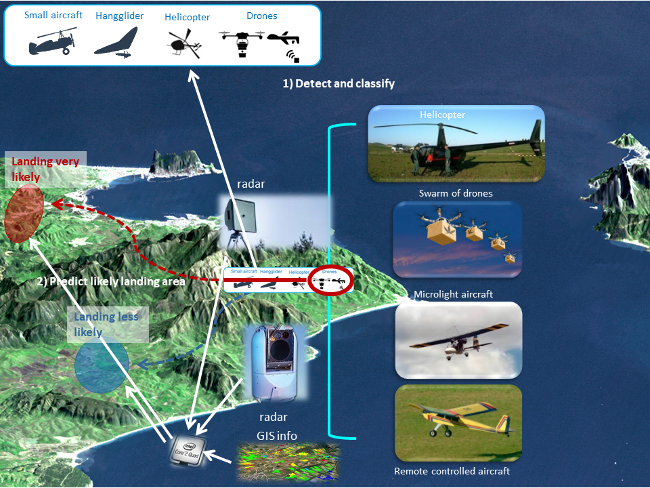| Stay up to date with project news, upcoming events and results | Subscribe to Newsletter |
Results of 1st period
ALFA provides a solution for the detection of small aircraft that are used to smuggle drugs from morocco to Spain and Portugal. The system will assist the policemen to hunt down and arrest the smugglers.
Protecting European borders against drug trafficking is vitally important. More and more, small aircraft are used that can cross the sea border (almost) undetected due to their small size and low flight altitude. A hot-spot in this respect is the Strait of Gibraltar where many cases of airborne drugs smuggling are reported. Drones are already widespread used at the US-Mexican border. It is just a matter of time until drones are used in Europe too. Drones also can be launched from vessels close to the coast. Efficient pursuit of drug trafficking requires timely warning and knowledge of the intended landing site or dropping zone. This will allow law enforcement entities to intercept the drugs and smugglers on the ground, as well as the pilot in case of landing. Timely warning cannot always be obtained from existing coastal surveillance systems. Aircraft are small and often low-flying, which makes them hardly visible. Trafficking aircraft typically fly at very low altitudes to avoid showing up on radar during night-time hours or at dawn. Existing radar systems are mainly designed for surface surveillance, in other words for detecting and tracking vessels of all kinds. A system is needed that can add the capability to detect small low flying aircraft and drones. To be able to hunt down and arrest smugglers on the ground, a prediction of the landing or dropping zone is needed. The ALFA project is developing a system that can cope with the above mentioned situation. The ALFA system consists of radars, cameras and other sensors that are specifically designed to detect small aircraft and drones. Moreover, the system can reveal much information about the craft, like for example the rotational speed of the engine and, for a drone, the number of rotors. This all helps the identification of the drone or aircraft.

The following ground breaking objectives are paramount for ALFA:
-
New radar technologies:
Radar is the basis for the system. Existing radar is optimized for the specific task of detecting the Low Slow and Small (LSS) targets in a maritime border environment. An essential part is adding new technologies like micro-Doppler for detecting and classifying LSS targets and making the solution future-proof. -
Advanced processing technologies:
ALFA’s extensive data fusion and information analysis (including behavioral analysis) is new in its ability to predict landing sites and dropping zones. Moreover it allows the overall objective to be met, which is not possible for a single sensor solution. -
Future sensor technologies:
ALFA’s additional RF sensor solutions (which are passive radar and RF radio-localization system) are for the first time used for maritime border surveillance for larger distances. They will also add to the capability for future evolution of the ALFA system. -
Advanced architectural design:
A new open architecture will be developed that allows any number of relevant heterogeneous sensors to be connected. This makes the ALFA a scalable and flexible system, thereby enabling implementation of future developments.
During the first 18 project months the following work was performed:
- An extensive study has been performed to the type of aircraft that could fulfil the smugglers needs. The inventory encompasses relevant fixed wing, helicopter and UAVs.
- Visits have been made to GC and GNR to obtain a good view on the operational aspects of the combatting of drug trafficking. Their requirements with respect to detection of drug trafficking have been discussed.
- The architecture design has been detailed, including sensors and processing, information flow and data model, and provisions for connection with other systems (SIVE, SIVICC)
- Radar technology has been developed that enable radar to detect small aircraft in a sea clutter environment. The development of specific microDoppler technology for ALFA allows for the extraction of various attributes of the drone or aircraft.
- Software is being developed for data fusion, detection, classification, tracking, feature extraction, behavioural analysis, threat analysis and landing site prediction.
- Tests have already been performed with the SQUIRE radar and the passive RF system.
- First steps have been made in the preparation of the final demonstration.

